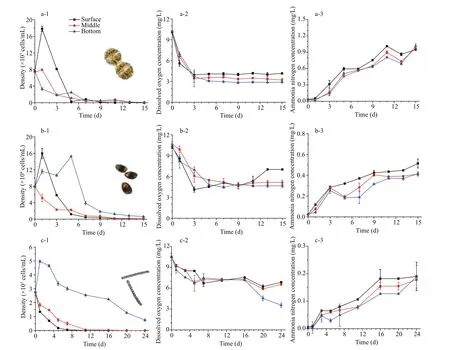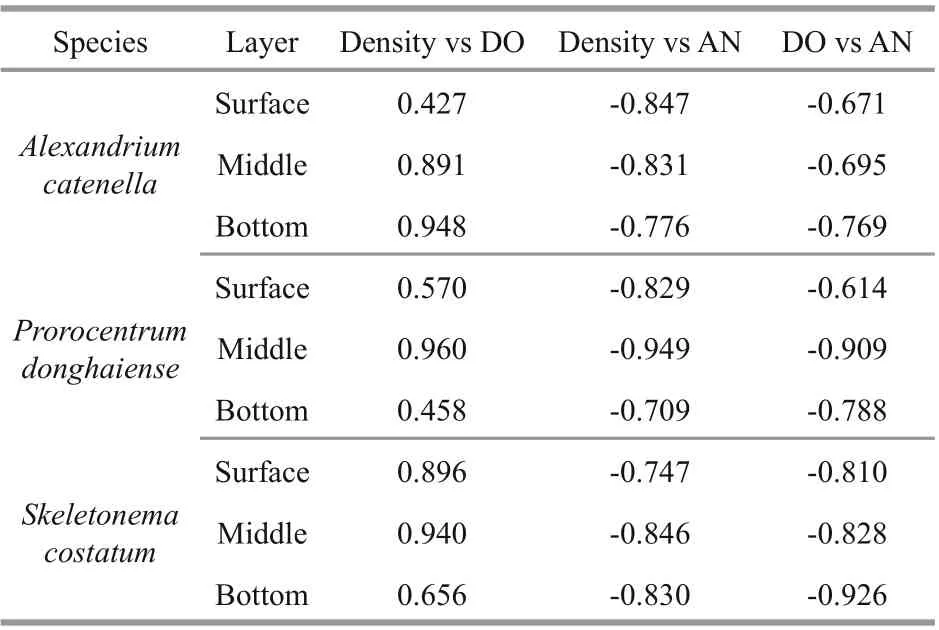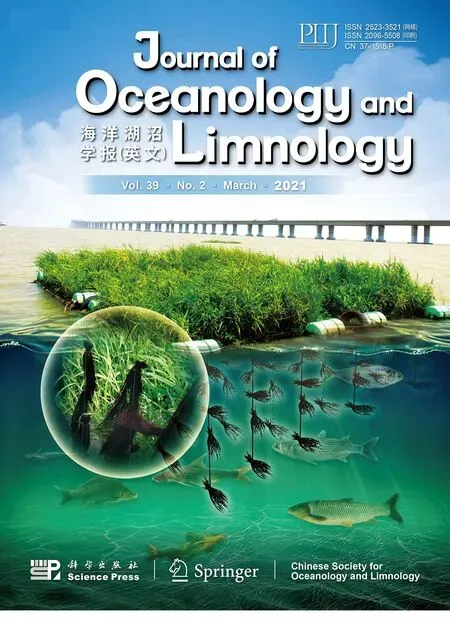Laboratory simulation of dissolved oxygen reduction and ammonia nitrogen generation in the decay stage of harmful algae bloom*
Qiaoning WANG, Xiaodong LI , Tian YAN , Jingjing SONG ,Rencheng YU ,2,3, Mingjiang ZHOU
1 Key Laboratory of Marine Ecology and Environmental Sciences, Institute of Oceanology, Chinese Academy of Sciences,Qingdao 266071, China
2 Laboratory of Marine Ecology and Environmental Science, Qingdao National Laboratory for Marine Science and Technology,Qingdao 266071, China
3 Centre for Ocean Mega-Science, Chinese Academy of Sciences, Qingdao 266071, China
4 Key Laboratory of Marine Biotechnology of Fujian Province, Institute of Oceanology, College of Animal Sciences, Fujian Agriculture and Forestry University, Fuzhou 350002, China
5 CAS Key Laboratory of Coastal Environmental Processes and Ecological Remediation, Yantai Institute of Coastal Zone Research, Chinese Academy of Sciences, Yantai 264003, China
6 University of Chinese Academy of Sciences, Beijing 100049, China
Abstract To evaluate how the decay of bloom-forming algae aff ect the coastal dissolved oxygen, a laboratory simulation was conducted in terms of three typical harmful algae, Alexandrium catenella,Prorocentrum donghaiense, and Skeletonema costatum. Algae of same biomass (55 μg/mL) were conducted in lightproof columns, and the cell density, dissolved oxygen (DO), and ammonia nitrogen of diff erent layers were monitored at certain time series. Results show that the decomposition of algae significantly decreased the DO, and increased the ammonia nitrogen in all layers; and significant deference between diff erent species was observed. The A. catenella treatment showed the lowest DO (average concentration of 3.4 mg/L) and the highest ammonia nitrogen (average concentration of 0.98 mg/L) at the end of test,followed by P. donghaiense; and the S. costatum showed relatively high DO and low ammonia nitrogen due to slow decay rate. Results indicate that decomposition of harmful bloom algae, especially dinoflagellate,would cause significantly DO depletion and toxic ammonia nitrogen increase, which will detrimentally aff ect both pelagic and benthic ecosystem.
Keyword: harmful algal bloom; hypoxia; Alexandrium catenella; Prorocentrum donghaiense; Skeletonema costatum
1 INTRODUCTION
Marine eutrophication, especially the coastal and estuarine eutrophication, which is highly related with human activities (Micheli, 1999; Howarth and Marino, 2006; Jessen et al., 2015), resulted in frequent harmful algal blooms (HABs) and marine dissolved oxygen reduction (Glibert and Pitcher, 2001; Karlson et al., 2002; Small et al., 2014; Chan et al., 2019), and caused huge ecosystem destruction and massive mortality of aquaculture species (Morrison et al.,1991; Reise and van Beusekom, 2008; Li et al., 2017).Occurrence of hypoxia and anoxia zone (dissolved oxygen (DO)<2 mg/L or =0 mg/L) could have detrimental impacts on both pelagic and benthic organism (Diaz and Rosenberg, 1995; Marcus, 2001;Vaquer-Sunyer and Duarte, 2008). It was suggested that both the benthic community structure (biomass,diversity, density, distribution, organism size, and function, etc.) and process (rates and depth of bioturbation, biochemical zonation, and productivity,etc.) were significantly aff ected by marine hypoxia(Hartmann et al., 2009; Shivarudrappa et al., 2009,2019; Riedel et al., 2016; Fajardo et al., 2018; Yang et al., 2019), as well as those of pelagic community(Ekau et al., 2010; Kimmel et al., 2010; Elliott et al.,2013; Lučić et al., 2019). Survival rate, behaviour,reproduction of valuable culture species (fish and shellfish) and eco-key species (copepods) were also inhibited by hypoxia or moderate hypoxia (Stalder and Marcus, 1997; Lai et al., 2016; Gu et al., 2019;Samuel et al., 2019).
In addition to that the occurrence of hypoxia and anoxia zone were related with hydrodynamic factors,such as terrain, tide, and current (Luo et al., 2005; Shi et al., 2005), previous observation also suggested the HABs and marine dissolved oxygen reduction were also highly related (Glibert and Pitcher, 2001; Gentien et al., 2003). Morrison et al. (1991) reported a significant oxygen reduction of 2.0±0.3 mg/L after a diatom ( Skeletonema costatum) bloom in Firth of Clyde, Scotland, which caused massive mortality of herring ( Clupea harengus) eggs. Trainer et al. (2010)analyzed the impact of HABs on a typical upwelling coastal system, and suggested that large scale HABs could obviously reduce the DO level of upwelling coast. O’Boyle et al. (2016) suggested a significant liner relationship between dinoflagellate Karenia mikimotoi density and coastal DO concentration,using both field modelling and laboratory simulation.However, direct evidence of DO reduction caused by HABs species is still lacking, and laboratory simulation of this process on diff erent species is needed.
Coastal regions of China were recognized as the main aff ected region of both HABs and marine dissolved oxygen reduction. Hypoxia were observed almost everywhere throughout Chinese coastal regions (Wang et al., 2012a; He et al., 2014; Li et al.,2014; Zhang et al., 2016; Zhao et al., 2017), and annual hypoxia was reported in the Changjiang(Yangtze) River estuary, with a stunning coverage over 12 000 km2(Chen et al., 2007a; Wei et al., 2007;Li et al., 2011; Zheng et al., 2016). Large scale HABs,with bloom species including dinoflagellate and diatom, were frequently reported in this region. For example, blooms of the paralytic shellfish poisoning producer Alexandrium catenella covered an area of 1 000 km2near Zhoushan coast of Zhejiang Province in 2006. Prorocentrum donghaiense bloomed over 155 times during 2000-2009, with cumulative area over 6.7×104km2; and the diatom S. costatum annually blooms in this area (Liang, 2012). Their bloom area were highly consisted with the low oxygen region (Luo et al., 2005; Shi et al., 2005; Yu et al.,2018). Results of sediment analyses also indicated that the bottom oxygen lack in the Changjiang River estuary was related to massive biomass sedimentation of bloom algae (Guo, 2013; Kang et al., 2016). To explore the relationship of HABs and DO reduction,three typical bloom-forming species, A. catenella,P. donghaiense, and S. costatum, were selected; and the DO concentration changes, as well as the changes of algal density and ammonia nitrogen, were simulated and measured during algal decay in laboratory condition.
2 MATERIAL AND METHOD
The algae strains of A. catenella, P. donghaiense,S. costatum were provided by the Algal Culture Centre of the Institute of Oceanology, Chinese Academy of Sciences (IOCAS), and cultured in f/2 seawater medium (Guillard and Ryther, 1962) at temperature 20±1 °C, pH 8.09±0.05, and salinity 30±1 under a 12 h꞉12 h photoperiod using cool-white fluorescent lamps (2 650±100 lx). Culture cell numbers were counted by haemocytometer under a microscope. Seawater piped from Huiquan Bay,Qingdao, China (36°02′57.61″N, 120°20′118″E) were filtered through sand and 0.45-μm filter (Xinya,Shanghai, China), and autoclaved for 25 min at 121 °C before use.

Fig.1 Changes of hypoxia related parameters in diff erent algal treatments
Test was conducted in a one end closed, light-proof plexiglass tube ( φ=8 cm, length=3 m) with 15-L algal culture of A. catenella, P. donghaiense, S. costatum,respectively. Final densities of each algal were 0.74×104, 7.9×104, and 27.5×104cells/mL,respectively, which biomass were same at the bloom biomass of 55 μg/mL (dry weight, from unpublished data of Dr. SONG J. J. from IOCAS). Each algal treatment was conducted in triplicate at temperature 20±1 °C. Samples (5 mL×3) were taken from 30 cm(surface), 150 cm (middle), and 300 cm (bottom) at 0,1, 3, 5, 7, 9, 11, 13, and 15 d for A. catenella,P. donghaiense, and 0, 1, 3, 5, 7, 9, 11, 16, 20, and 24 d for S. costatum. Iodometry was used to measure the dissolved oxygen, and indophenol blue photometric method were used to measure the ammoniacal nitrogen, as recommend in National specification for marine monitoring of China(GB17378.4-2007) (General Administration of Quality Supervision, Inspection and Quarantine of the People’s Republic of China and Standardization Administration of China, 2007). Experimental data were analyzed by one-way analysis of variance(ANOVA) with the Statistical Package for the Social Sciences (SPSS) version 19.0 (SPSS, Inc., Chicago,IL, USA). Sample differences were considered to be statistically significant at P <0.05.
3 RESULT
During the long-term incubation in dark condition,the density of all three test algae were significantly decreased ( P <0.05) in surface, middle and bottom layer of the column (Fig.1). However, diff erent algal showed diff erent vertical migration during the incubation. Dinoflagellate showed significant surface gathering ( P <0.05) at day one, especially A. catenella,whose density in bottom decreased to 3 300±320 cells/mL, which is only 18.6% of that in surface(Fig.1a-1). The cells of P. donghaiense migrated to both surface and bottom, with pick density of(15.9±1.2)×104cells/mL (1 d) and (15.2±1.2)×104cells/mL (5 d), respectively, while the density in middle layer significantly decreased (Fig.1b-1).However, the cells of diatom S. costatum immediately sank to bottom of the column, and slowly decayed(Fig.1c-1). After 24-d incubation, the cell density of S. costatum in the bottom still maintained at(0.75±0.07)×105cells/mL (about 27.2% of bottom density at 0 d), while densities of A. catenella and P. donghaiense at each layer dropped to nearly 0 in fifteen days.

Table 1 Correlation among algae density, dissolved oxygen(DO), and ammonia nitrogen (AN) of each layer in three algae treatments
The DO concentration also showed significant decrease ( P <0.05) in all three layers, and slight difference was observed between diff erent algae(Fig.1). DO concentrations of three testing layers of A. catenella treatment significantly dropped ( P <0.05)to below 4 mg/L within three days, and maintained at about 4.1, 3.4, and 2.9 mg/L (surface to bottom) in the following days with little fluctuation (Fig.1a-2). The DO concentration in P. donghaiense treatment also declined rapidly, especially that in the surface, which dropped from 10.2±0.12 mg/L to 4.1±0.38 mg/L in three days. However, the surface DO increased to 7.0±0.04 mg/L in 13 d, while middle and bottom DO slowly decreased to about 5.0 mg/L on Day 9, and stayed with little fluctuation until the end (Fig.1b-2).The DO concentration of S. costatum treatment also declined, but the surface and middle layers DO remain above 5.0 mg/mL in the entire tests, which were significantly higher ( P <0.05) than that in the A. catenella treatment. However, the bottom DO dropped rapidly after Day 16, and it was tested as 3.6±0.31 mg/L on Day 24, which was significantly lower ( P <0.05) than that in middle and surface layers of same treatment.
The ammonia nitrogen significantly increased( P <0.05) in all test layer and treatment. In each algae treatment, the difference of ammonia nitrogen concentration between layers was not significant( P >0.05), but for diff erent algae treatment, their increasing degree were quite diff erent ( P <0.05). The averaged ammonia nitrogen in A. catenella treatment was tested as 0.98±0.049 mg/L on Day 15, which was about 5.3 times of that in S. costatum treatment on Day 24 and 2.2 times of that in P. donghaiense treatment on Day 15.
As shown in Table 1, the algae density was positively correlated with DO, and negatively correlated with ammonia nitrogen, while the DO was negatively correlated with ammonia nitrogen. It also showed that the correlation of those three parameters varied with algae species and layers. In A. catenella treatment, the algae density was strongly correlated with DO in both middle and bottom, while in P. donghaiense treatment, all three parameters were more closely correlated in the middle than other layers. The relation between DO and ammonia nitrogen were lower in most algae treatments and layers; however, they were strongly related in bottom layers of S. costatum treatment.
4 DISCUSSION
An interesting phenomenon of cell mobility was observed in this test, and obvious diff erent motility modes for three test algae were detected.Dinoflagellates were aggregated to surface layer on Day 1, even in the dark condition, which indicated an inner rhythm of vertical migration. It was suggested that the migration of A. catenella was the most obvious among the three test species, with surface density over double of middle density and five times of bottom density in 1 d (Fig.1a-1). The structural analysis of flagellar suggested that the A. catenella had strong movement ability (Hansen and Moestrup,1998). Lewis et al. (2006) suggested speeds of 30-470 μm/s for other Alexandrium species. However,the exact swimming speed of A. catenella was still unclear. P. donghaiense also have flagellum, and surface accumulation was observed on Day 1(Fig.1b-1), but in contrary to A. catenella, the bottom densities were also increased in six days, suggesting a diff erent migration mechanism. The diatom S. costatum has no movement ability, and significant descent was observed (Fig.1c-1). However, the decay of S. costatum was significantly slower than dinoflagellate. It may be related with the siliceous shell to keep the algal cells intact, which also related to its slow DO consumption.
Results also suggest that the DO reduction was related with the decay speed of algal cells. With biomass (dry weight) set at 55 μg/mL samely for each treatment, the reduction speed and degree varied with species. The decay speed of A. catenella was faster than other species, and its DO reduction speed was faster and degree was deeper than that of other treatment. The DO of A. catenella treatment was stable on a low level within 5 days, exactly when the heavily cells density declines happened. The decomposing of S. costatum was the slowest, so that the DO reduction speed was the slowest and the degree was the slightest among the three treatments.Results also indicate that DO reduction was partly related to the cells distribution, especially in the middle layer (Table 1). On Days 16-24, the decomposing of S. costatum caused the significant DO decline in the bottom (Fig.1c-1 & c-2). Moreover,the DO concretion may be influenced by other factors,such as surface exchange, making DO concentrations decline with water depth.
Ammonia nitrogen increase was noticed.Decomposing of massive algae, in both micro and macro level, would generate huge amount of ammonia nitrogen (Branch et al., 2013; Wang et al., 2012b).Significant difference was observed between algae treatments. The final concentration (on Day 15) of ammonia nitrogen in A. catenella treatment was the highest among the three treatments, which might be caused by the high nitrogen content itself. The ammonia nitrogen concentrations of the three algae were highly consistent with the nitrogen content of algal cells (unpublished data). Ammonia nitrogen was very lethal to marine fauna, especially to their larva or juvenile. Reddy-Lopata et al. (2006) suggested that survival of the juvenile abalone Haliotis midae(length 1-2 cm) was significantly inhibited by ammonia nitrogen at concentration of 7.4 μg/L, which was much lower than ammonia nitrogen released by algae in this article. Lethal or other adverse eff ect also reported for clam (Wang et al., 2007; Chen et al.,2010), amphipods (Kohn et al., 1994), and fish (Zhu et al., 2018).
The results provide direct evidence that decay of harmful species could cause DO reduction and ammonia nitrogen increase in a still water, which was considered as a reflection of real coastal environment.All the tested algae in this research frequently bloomed along coasts of China, especially P. donghaiense and S. costatum, with hundreds bloom cases reported, in vast bloom area and high algal density (Liang, 2012). In the Changjiang River estuary, density of annual bloom of P. donghaiense were over 105cells/mL (Yu et al., 2018), suggesting that the DO might be lower than 4 mg/L in several days with increased ammonia nitrogen according to our results. This may cause detrimental impacts to both pelagic and benthic organism, and further lead to a great damage to the coastal ecosystem.
5 CONCLUSION
The laboratory simulation has proved that the decay of harmful algae could significantly decrease the DO in the water column, and the results show that the ammonia nitrogen increased with simulation time.However, the degree of DO consumption and ammonia nitrogen production varied with algal species, with the degree order (strong to weak) as A. catenella, P. donghaiense, and S. costatum, which could be explained by difference in decay rate and elementary composition between species. The decay of massive HABs, especially dinoflagellate blooms,could cause significant DO consumption and toxic ammonia nitrogen increase, which have a detrimental impact on both pelagic and benthic ecosystems.
6 DATA AVAILABILITY STATEMENT
The datasets generated and/or analyzed during the current study are available from the corresponding author on reasonable request.
7 ACKNOWLEDGMENT
We thank the anonymous reviewers for valuable comments and the editors for manuscript polishing towards the improvement of this paper.
 Journal of Oceanology and Limnology2021年2期
Journal of Oceanology and Limnology2021年2期
- Journal of Oceanology and Limnology的其它文章
- Predicting sediment flux from continental shelfislands,southeastern China*
- Development of high-resolution chloroplast markers for intraspecific phylogeographic studies of Phaeocystis globosa*
- Effects ofiron and humic acid on competition between Microcystis aeruginosa and Scenedesmus obliquus revealed by HPLC analysis of pigments*
- Effect of river plume on phytoplankton community structure in Zhujiang River estuary*
- Exploring the sublethal genotoxic effects of class II organophosphorus insecticide quinalphos on freshwater fish Cyprinus carpio
- An illustrated checklist of macrofaunal molluscs from softsediments of the Abrolhos Parcel (northeastern, Brazil) with 15 new records*
